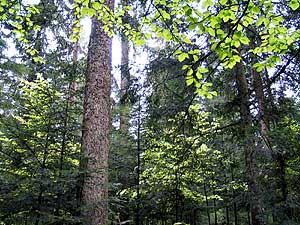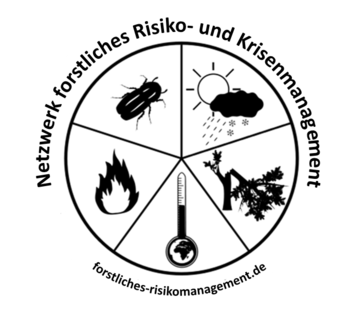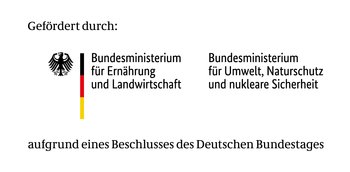The occurrence of insect pests in great numbers always leads to economic losses in the forestry sector in both the regional and the local level. There are different prevention measures to decrease the risk of calamities from insects. On the one hand there is a continuous monitoring of the insect populations in our most essential forests (The Monitoring and Prognosis of Insect Pests), and on the other hand it is the responsibility of forest personnel and managers to stabilise our forests with an adapted, sustainable forest management against insect pests.
The measures for integrated forest protection provide short-term results but are constant to maintain. A move away from even-aged, monoculture to site specific, structurally rich, mixed forests is the most important goal of prevention. The results will however, be observed only in medium to long term.
Near-natural and Sustainable Forests

Fig. 1: Near-natural mixed forest in the south of The Black Forest. (Photo: T. Weidner)
The best long-term prevention against insect disasters are near-natural, stable and structurally rich forests, where their own balance of power exists. This turns out to be an achievement of almost near-natural or natural forest management practice. This management system ensures the statutory provisions for so-called ‘proper’ and thus sustainable forestry. Approved certification systems such as the FSC and PEFC, whom the forest mangers willingly subject themselves to, compliment these provisions. The demands on the forest and payment for the protection of natural resources are borne together by society as a whole.
Disruptions to our forest ecosystems through insect disasters are also expected in the future, possibly even to a greater extent than previously seen, due to climate change. These disruptions can be tolerated, so long as the forests are not affected in such a way, that the most important functions (use, protection, welfare and recovery functions) are impaired. Otherwise, managers need to take the appropriate defensive measures to protect the forests.
Legal Regulations for Forest Protection
In addition to protecting the interests of forest owners, their forests from damage and pests, the wood and forest laws must also contain regulations for forest protection. Essentially, these are the requirements to manage forests properly and sustainably, as well as prevent damage to a forest. Therefore, forest protection is present in all laws. Further measures for protection against forest fires are often established as are measures against biotic pathogens.
| Tab. 1: Overview of the main legal requirements for forest conservation in the KoNeKKTiW-states. Abbreviations: LWaldG = State Forest Law, LForstG = National Forest Act. Status: 05/2012 | |||
| State | Management | Defensive Measures | Other |
| Baden- Württemberg | LWaldG
| LWaldG
|
|
| Mecklenburg- Vorpommern | LWaldG
| LWaldG
| LWaldG
|
| Nordrhein- Westfalen | LForstG
| LForstG
| LForstG
|
| Rheinland-Pfalz | LWaldG
| LWaldG
| LWaldG
|
| Sachsen | SächsWaldG
| SächsWaldG
| |
| Schleswig-Holstein | LWaldG
| LWaldG
| LWaldG
|
| Austria | Forstgesetz 1975 i.d.g.F.
| Forstgesetz
| |
Tab. 1: Overview of the main legal requirements for forest conservation in the KoNeKKTiW-states. Abbreviations: LWaldG = State Forest Law, LForstG = National Forest Act. Status: 05/2012
Using an example from Mecklenburg-Vorpommernand and with the additional links below you can find out about the opportunities for the prevention of insect damage.
External Links
Forest Crises Management Advisory Guide
Back to the main page of the Forestry Crisis Management Advisor Guide: Overview of the different topic collections
Back to the article overview in the: The Insect Pest Topic Collection: Prevention – Identification – Action




![[Translate to English:] [Translate to English:]](/assets/FVA/Waldwirtschaft/WS-Info_121_Holzbrueterbefall/fva_rindenbrueter_2.jpeg)